“Seven cosmoses depend from each constructor.”
Book of Jubilee, Chapter 3
Here is one understanding of the way in which cosmoses and worlds arise from the six constructors. Each constructor is a particular combination of the three mothers. For example the constructor called contraction, UAD, has the unifying mother in the first place, the affirming mother in the second and the denying mother in the third place.
The constructors make cosmoses by joining together head to tail – that is, the final mother in one become the first mother in the next. A cycle of constructors each connected to the next in this way forms a cosmos.
The First Cosmos in the First World
The first cosmos depending from UAD is the constructor and its mirror DAU. The cosmos forms an endless cycle of UAD-DAU–UAD-DAU-UAD… Contract-Repeat-Contract-Repeat… reflecting back and forth.
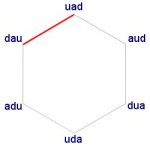
There will be two other similar cosmoses made of other mirror pairs. These three cosmoses together form the first world:
“The first world’s beings are the substance of that world, the hierarchical world. They come into being out of the six by combination of any two mirrors. Such beings do not yet have perceptible existence. They are the seeds of the multiverse, one turning one way, one the other. From their pairings are formed the bases of growth, compression and change. As yet time and space do not arise; in themselves they contain all the possible creations. It is the world of Gods—Gods in the likeness of fiery serpents or infinite vortices or the Miracle Gods who change the aspect of all received by them. It is a world of mirrors, ‘in our own likeness’.”
The Second Cosmos in the Second World
The second cosmos is formed by three constructors UAD-DUA-ADU.
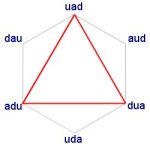
There is another cosmos formed from the other three constructors: UDA-AUD-DAU. These two cosmoses together form the second world:
“The second world’s beings are also identical with the substance of their world. It is the substance of time and space, the world of resilience. When time expands, space expands; when time changes, space changes. The smaller the object, the faster its time; the greater the object’s extent, the greater its cycle of time. Wheels creating, adapting and replicating, spinning in all directions, weaving the fabric of space; Orbs expanding, shrinking and mutating, forming the extent and substance of all creations; each is dependent on the other. In this world all the possible universes are laid down in possible extent and possible duration. Here is the world of birth and death, the multiverse.”
Cosmoses 3 & 4 in the Third World
The third and fourth cosmoses dependant from UAD are each formed by four constructors:
UAD-DUA-AUD-DAU and ADU-UAD-DAU-UDA.
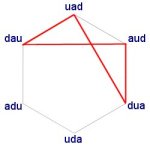
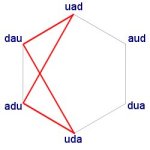
These two, together with a third cosmos of four constructors excluding UAD form the third world:
The denizens of the third world, the world of growth, are of two types, one in which a God conceals a follower’s God, and one in which a God is concealed by a leader’s God. In each the other lies hidden: it is a world of appearances, a world of duality where the serpents of growth are hidden in change or compression, the heralds of change are hidden by compression or growth, the vortices of compression are hidden in growth or change. It is the world of universes dependent on one constructor.
Cosmos 5,6,7 in the Fourth World
There are three cosmoses made of all six constructors:
UAD-DAU-UDA-AUD-DUA-ADU
UAD-DUA-ADU-UDA-AUD-DAU
UAD-DUA-AUD-DAU-UDA-ADU
When drawn out, each of them has a similar shape, reminiscent of an enneagram – of which more later.
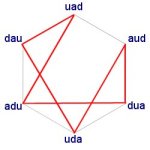
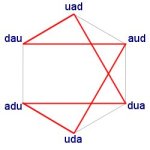
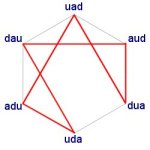
These three together make the fourth world:
“The fourth world, the world of structure, is inhabited by three types of material beings. In one the denying is fixed, in another the affirming has become active, and in the third the unifying has acquired material existence. They correspond to those material beings in whom only what they receive from outside exists, those beings in whom what is outside of themselves has to be related to what is inside them, and those beings who impose on the outside their internal worlds of possibilities. All three possess within them the other three worlds in due proportion, two parts from the first, two from the second and two from the third: in all these living beings the possibility exists to perceive the whole of creation.”
A good starting point for working with the worlds and cosmoses is to write down your own list of all the combinations from each constructor. How many are there, and why just that number? Which are repeated, and how many times? Why?
Consider the patterns within each cosmos. For example, the third world cosmoses have mirrors within them. What are their relationships? How much of the description of each world do you think comes from the patterns?